|
Supporters of Miami Marine Stadium Raise $50,000 for Restoration Study
Icon aided by listing on the National Trust list of Most Endangered Historic Places
by Russell Boniface
Associate Editor
Summary: World Monuments Fund and the National Trust for Historic Preservation, working with a coalition of Miami organizations, recently raised $50,000 to commission an engineering study to determine restoration cost of the landmark Miami Marine Stadium, a Modernist icon in Biscayne Bay. AIA Miami has also been instrumental in the preservation efforts. The 6,500-seat grandstand stadium, currently unoccupied, is built entirely of poured concrete and features a dramatic cantilevered fold-plate roof.
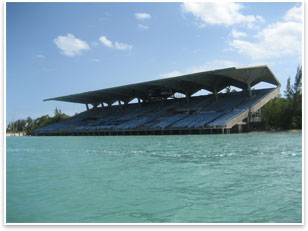
World Monuments Fund and the National Trust for Historic Preservation, working with a coalition of Miami organizations, recently raised $50,000 to commission an engineering study to determine the restoration cost of the landmark Miami Marine Stadium, a Modernist iconic in Biscayne Bay. Photos courtesy of Friends of Miami Marine Stadium.
Miami Marine Stadium was recently included on the National Trust for Historic Preservation’s 2009 list of America’s 11 Most Endangered Historic Places and has been nominated to the 2010 World Monuments Watch biennial list of 100 most endangered sites, which will be announced in October 2009. Friends of Miami Marine Stadium, which is under the umbrella of Dade Heritage Trust, has been pivotal in the preservation efforts.
World Monuments Fund, an organization devoted to saving treasured places, and the National Trust for Historic Preservation helped the coalition to raise the amount for the new engineering study. The coalition also includes Friends of Miami Marine Stadium, under the umbrella of Dade Heritage Trust; The Villagers, which is the oldest preservation organization in Miami-Dade County; the John and Selene Devaney Foundation; and Miami-Dade County Commissioner Carlos Gimenez.
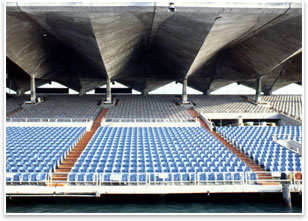
The stadium’s unique design elements include a dramatic concrete fold-plate canopy forming a zig-zag pattern of triangles suggesting waves and sails. From the water, the grandstand seats and the zig-zag concrete above them form an image of alligator jaws.
The partners expect the results of the study, due later this fall, to help guide decision-making about the future of the facility, designed by Cuban-born architect Hilario Candela and built in 1963. Boston-based Simpson Gumpertz & Heger, Inc. (SGH) will do the structural analysis and core drilling to determine the cost of restoring the stadium. This is the second time SGH assessed the structure’s condition and feasibility for restoration. In 1993, SGH’s visual inspection determined that the stadium, closed after Hurricane Andrew in 1992, could be restored for $2-3 million. Repairs were never carried out, and the stadium remains vacant in a state of neglect. The city is in the process of revising a master plan for Biscayne Bay that would include the restored stadium. The coalition is hoping for a revised restoration cost estimate.
Miami community rallies to save an icon
The 6,566-seat stadium sits on a strip of land on Biscayne Bay. The structure faces Virginia Key island and is separated by a man-made basin. The facility was originally built for spectators of power boat races and was also the site of concerts, including Jimmy Buffett and the Boston Pops, who performed on a floating stage on Biscayne Bay. The stadium’s unique design elements include a dramatic concrete fold-plate canopy forming a zig-zag pattern of triangles suggesting waves and sails. From the water, the grandstand seats and the zig-zag concrete above them form an image of alligator jaws. Plus, part of the grandstand extends into the Bay, suggesting a floating structure.
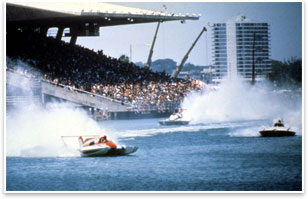
The facility was originally built for spectators of power boat races and was also the site of concerts, including Jimmy Buffett and the Boston Pops, who performed on a floating stage on Biscayne Bay.
Friends of Miami Marine Stadium has played a major role in building momentum to preserve the facility. Last January, it held a meeting discussing the future of the stadium, with 200 attendees including city and county commissioners. “We had organizations and event promoters talk about how they would use the stadium,” says Donald Worth, cofounder of Friends of Miami Marine Stadium. “One of the issues is that saving it is great, but what are you going to use it for? But I think people came away with a very strong sense that this could work.” He envisions concerts and other events upon renovation.
Worth says that designation by the National Trust for Historic Preservation of being one of America’s 11 Most Endangered Historic Places provided a new raft of national and local publicity. Moreover, he says, “World Monuments Fund led the effort to help us secure funding.” He hopes that the city, in the process of revising its master plan for Biscayne Bay, will help make the stadium one of the centerpieces for its restoration.
More organizations have become involved to offer support and assistance. “It is a real community effort,” Worth adds. “Miami Marine Stadium is more than a great building—it is an amazing public gathering space. The flip side is more people who never looked at this as great architecture have a greater understanding of why a building like this can be significant. It personifies Miami. It is flamboyant; comes from the 60s, an era that people remember; is on the water; and encompasses what is great about Miami. The stadium is where many wonderful things have happened.”
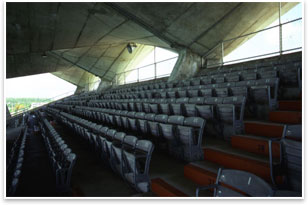
Miami Marine Stadium was recently included on the National Trust for Historic Preservation’s 2009 list of America’s 11 Most Endangered Historic Places and has been nominated to the 2010 World Monuments Watch biennial list of 100 most endangered sites, which will be announced in October 2009.
Restoring a Modernist structure to former glory
“What better symbol could there be of Miami’s ties to the waterfront than the fantastic Marine Stadium?” asks Lisa Ackerman, World Monuments Fund executive vice president and chief operating officer. “The Marine Stadium, taken together with the man-made basin and natural setting, embodies the exuberance of a city that has contributed greatly to American artistic and cultural life. World Monuments Fund wants to see Miami Marine Stadium restored to its former glory so that spectators, concert-goers, and the public can once again marvel at the double joy of great architecture and a waterfront view.”
“Modernist architecture reflects a remarkable time in our cultural development,” says Richard Moe, president of the National Trust for Historic Preservation, “and Miami Marine Stadium, an integral part of Miami’s robust and diverse history, is an especially important place we can’t afford to lose.”
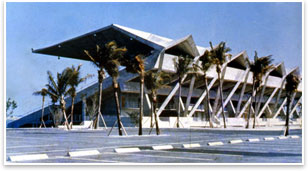
The 6,500-seat grandstand stadium, currently unoccupied, is built entirely of poured concrete and features a dramatic cantilevered fold-plate roof.
What’s next?
“There are significant challenges that remain and ultimately involve the next steps of the city,” says Worth. “After they finish their master plan, which we are involved with, the city will issue a request for proposals, and one aspect of that will be the stadium. The city will be looking for an outside management entity. Our role is to be midwife and encourage responses from appropriate organizations that have the ability to run the stadium and encourage them to respond to the city.”
Worth says Friends of Miami Marine Stadium is aware of interests who, he says, can successfully run the facility. “That’s important,” he points out. “The building is great, but you have to have it run properly. Beyond that, there is the issue of funding to restore it. We hope to have a better cost estimate. When we get that, we believe we will have to foster a public-private partnership to finance this, combining funding sources.” Worth adds that naming rights and the sale of the historic tax credit could provide additional income streams. |







